Crossroads MVP
Dice System
Crossroads System
Dice
 This game uses a 3d6 system to determine the success of certain actions. After rolling, the results are added to find the total. Most rolls will require at least 3d6 but sometimes more will be needed, up to 6d6 maximum.
This game uses a 3d6 system to determine the success of certain actions. After rolling, the results are added to find the total. Most rolls will require at least 3d6 but sometimes more will be needed, up to 6d6 maximum.
A d6 is a six-sided die. If “die” or “dice” is mentioned, it will be a d6.
|
|
|
|
Example |
| A = |
Advantage |
Roll number more dice, remove least favourites. |
a2 |
| D = |
Disadvantage |
Roll number more dice, remove favourites. |
d1 |
 Modifiers
Modifiers
Modifiers are written as the letter followed by a number (a1, d2 etc). These are grouped into Advantage/Disadvantage. If a roll has both Advantage and Disadvantage, these values will cancel each other out until there is only one (or none). For example, a2 and d1 would become a1.
If a roll has Advantage/Disadvantage, the choice is made before dice are re-rolled. This can be dice re-rolled from Fate Dice or from Dice Multiples.
Advantage and Disadvantage Examples
A player is asked to roll 3d6 with Advantage, or 3d6a1.
They roll 1 extra die (4d6) and then they remove 1 of the dice.
If they rolled5432 , they would remove the2 , for a total of 12 (543 ).
A player is asked to roll 3d6 with 2 Disadvantage, or 3d6d2.
They roll 2 extra die (5d6) and then they remove 2 of the dice.
If they rolled54321 , they would remove the5 and4 , for a total of 6 (321 ).
When in doubt, the GM can choose the dice.
— Advantage/Disadvantage and Damage
Because Damage is static in Crossroad MVP, Advantage lets you add D, or turn a D into a D or DD into a D.
Similarly, Disadvantage reduces damage by D or reduces a D into a D or D into DD.
a1 and d1 cancel out, just as normal.
— Type Modifiers
Certain attacks or abilities may have a type associated. This might interact with other effects, such as Resistance, Immunity, or Vulnerability.
 This is explained further in the Combat — Taking Damage section.
This is explained further in the Combat — Taking Damage section.
Modifier Limit
Advantage/Disadvantage may never exceed 3 on a single roll. Any Modifiers beyond this limit are reduced to 3.
Example:
You may have 3d6 a3 but not 3d6 a4.
 Skill Rolls
Skill Rolls
The majority of conflicts will be resolved with Skill Rolls. This includes climbing walls or attacking foes. Anything that has an outcome that is unclear will probably be resolved with a Skill Roll. There are multiple possible outcomes with different effects.
The Success Value is determined by rolling 3d6, applying any Modifiers or Statistic, and then comparing the total sum to the chart below:
| Roll |
Success |
Value |
Name |
| 1 - 7 |
(−1) |
|
Miss |
| 8 - 11 |
(0) |
|
Weak Hit/Weak Miss |
| 12 - 15 |
(1) |
|
Hit |
| 16+ |
(2) |
|
Strong Hit |
Result
If there is no opposing roll, then the Result is equal to your Success Value. However, sometimes there is an Opposing Roll. When this is the case, the Result is modified by the Success Value of the Opposing Roll. Results are usually limited to being between −1 and 2.
 Opposing Roll
Opposing Roll
An Opposing Roll occurs when one character attempts to avoid the action of another character. This might be an attempt to dodge an attack or an attempt to resist the effects of a spell.
The Success Value of the Opposing Roll is subtracted from the Success Value of the initial Skill Roll.
| Examples: |
| Hit |
(1) |
− |
(1) |
Enemy Hit |
= |
[0] |
Partial Success |
(1 - 1 = 0) |
| Weak Hit |
(0) |
− |
(−1) |
Enemy Miss |
= |
[1] |
Success |
(0 - (-1) = 1) |
| Miss |
(−1) |
− |
(2) |
Enemy Strong Hit |
= |
[−1] |
Failure |
(-1 - 2 = -1) |
Opposed Roll Example:
An Elf with a Sword tries to attack an Orc with a Shield (SV1).
The Elf makes an Attack Roll against the Orc, rolling 3d6 and adding her [d]exterity Statistic.
She rolls 10 (532), adding 1[d] and scoring 11. It's a Hit (1)!
The Orc attempts to avoid the attack, making an Avoidance Roll.
He can choose to Block, Dodge, or Parry, and decides to Block with his shield.
The Orc makes a Block Avoidance Roll against the Elf's Attack, rolling 3d6 and adding the SV of his shield. He rolls 13 (641), adding 1 SV and scoring 14.
It's another Hit (1)!
Both parties rolled a Hit (1) so the Total Result is a Partial Success [0]. (1 − 1 = 0)
The player can choose if they want this to be a Partial Success [0] or a Compensating Failure [0].
The GM will always let the player make the choice.
— Peril Die
Sometimes, rather than rolling for an enemy or using a static score, one of the dice rolled by the player can be the Peril Die. This result will help determine the opponent's result more quickly, but with some variety.
When players roll 3d6, make sure one of the dice is different in some way (6 6 6). This is the Peril Die.
If the Peril Die is equal to or lower than the value below, based on the Opponent's Statistic, the Opponent's Roll will be a Hit(1) or Strong Hit(2) accordingly. Otherwise, the Opponent's Result is a Weak Hit (0).
Opponent
Statistic |
−2 | −1 | 0 | 1 | 2 | 3 | 4 | |
| Hit (1) |
|
1 | 2 |
3 | 4 |
5 | 6 |
*Automatic Success |
| Strong Hit (2) |
|
| |
| 1 |
2 | 3 |
|
If the Opponent has Advantage/Disadvantage, move the required number by 1. If the player has Advantage/Disadvantage, this doesn't affect the Peril Die.
Peril Die Example:
An Elf with a Sword tries to attack an Orc with a Shield (SV1).
The Elf makes an Attack Roll against the Orc, rolling 3d6 and adding her [d]exterity Statistic.
She rolls 10 (532), adding 1 [d] and scoring 11. It's a Hit (1)!
The Orc attempts to avoid the attack, making an Avoidance Roll.
He can choose to Block, Dodge, or Parry, and decides to Block with his shield.
Instead of making a Block Avoidance Roll against the Elf's Attack, the result of the Peril Die is compared to the SV of his shield.
Because the SV is 1, when the Peril Die 3 is compared to the chart above, we see it's another Hit (1)!
If the Elf is able to reroll any of the dice, they might reroll the 3 and hope for a higher number to reduce the Orc's result to a Weak Hit (0).
This is an optional rule.
 Skill Rolls are explained further in the Actions — Making a Skill Roll section.
Skill Rolls are explained further in the Actions — Making a Skill Roll section.
 Results
Results
Results can be summarised as follows:
| Success |
Value |
Name |
Description |
| [−1] |
|
Failure |
Action Failure, and possibly an additional complication. |
| [0] |
|
Compensating failure |
Action Failure, but with a benefit. |
| [0] |
|
Partial success |
Action Success, but with a complication |
| [1] |
|
Success |
Action Success |
| [2] |
|
Great Success |
Action Success, with additional benefit. |
[−1] Failure
Miss / "No"
The action fails. Whatever the character was trying to do, it’s unsuccessful. An attack misses or a spell fails to affect the target. The target isn’t spotted or the attempt at intimidation falls flat. When failing an Attack Avoidance Roll, the attempt at avoidance fails completely, possibly even making things worse. Sometimes a Failure results in damage taken, such as a Failure while climbing, which may result in a fall, or if attempting an Avoidance Roll, failing to avoid an attack. The GM will decide the outcome of Failure if it isn’t specified.
A Result of a Failure should not mean that nothing happens. It is highly recommended to have characters "Fail Forward" or have other complications arise upon a failure. The response to a Failure should not be an immediate "Try again".
[0] Compensating Failure
Weak Miss / "No, but..."
The task fails, but something is gained. When rolling for an offensive action, the action fails but an Advantage may be gained for future attempts or for another action. When rolling defensively, the enemy action might succeed, but an Advantage is gained for future avoidance attempts, or another opportunity presents itself.
Maybe an attack fails but grants an advantageous position, or an enemy attack gets through but leaves their defences open for a counter-attack. A spell might go off, but next time it won’t. A failure to climb a wall, but now the cause is clear and you have learned from your failure.
[0] Partial Success
Weak Hit / "Yes, but..."
Success, but at a cost. Maybe the attack is successful, but both parties took some damage. The spell might be successful, but took more effort and the caster is drained. It’s possible the jump is made, but something is dropped. The attack may hit, but only barely. Similar to Compensating Failure, this result has both a good and a bad. While Compensating Failure is a failure with an advantage, this is a success with a disadvantage. This may be damage taken, penalties to future rolls, or lost items. This is up to the GM.
Players usually choose between a Compensating Failure and a Partial Success. GMs can look at the Player Choices section within the Gamemastering Section for more information.
[1] Success
Hit / "Yes"
The action succeeds! The attack hits, the spell goes off, or the enemy is spotted. Whatever the Skill Roll was for, the result is good. Better than failure anyway.
[2] Great Success
Strong Hit / "Yes and..."
The action doesn’t just succeed, it surpasses expectations. The attack doesn’t just hit, the enemy is also knocked backwards or disarmed. The diplomacy session went so well that they even threw in extra for free. This result is just like a Success, but there is an added bonus. Similar to Compensating Failure but without the failure, there is now an extra opportunity or advantage. This can be something as simple as a bonus to the attack roll, or on the next skill roll.
Sometimes this just means the action was performed so effortlessly that it impresses anybody nearby. A polite round of applause might be in order.
For more information see Game Mastering – Skill Rolls.
 Critical Hit
Critical Hit
If one of the dice rolled is a 6, and the final Result is Success [1] or greater, it's considered a Critical Hit.
Alternatively, a Great Success [2] may be treated as a Critical Hit instead of using any other rules or Benefits.
Although a Critical Hit has no effect by itself, certain Paths or Items have special rules for Critical Hits.
Critical Hit Examples:
A Noble attacks a Goblin with a dagger.
Rolling 6 4 2, they score a Hit (1).
If the final result is a Success [1], it's a Critical Hit!
However, if the Goblin's Avoidance Roll reduces the Result to Partial Success [0], it is not a Critical Hit.
Example: Path of Piercing allows an attack ignore A on a Critical Hit with a piercing weapon.
 Success Value Amount
Success Value Amount
Sometimes, when there is no Opposed Roll for an Ability, there might be rules for the Success Value Amount. In this case, the Value is equal to the number in brackets, such as Hit (1) giving a value of 1.
If the roll is a Critical Hit, the Success Value Amount is 1 higher.
- Partial Success [0] 0
- Success [1] 1
- Critical Hit 2
- Great Success [2] 2
 Group Roll
Group Roll
If the entire group is trying to do something, such as search a room, it's best to let only one person roll. Their success or failure counts for all members of the party. Certain actions might gain Advantage if the entire party is working together, but it's best to just use the highest Statistic.
This helps speed things along, and prevents every character rolling for the same thing.
Simple Group Roll Example:
The party enters a room that's been ransacked. The Dwarf asks to search for evidence. The Elf and Noble offer to help with the search.
The Elf has the highest [p], so she rolls.
Sometimes an Action may be need to be performed by the entire Group, such as an attempt to hide or bluff or climb, where failure of one is failure for all. However, characters may assist one another, so any Hit (1) can counteract a Miss (−1).
In these situations, the following process is used:
- Every player makes a Skill Roll.
- Each Hit (1) must be used to "cancel" a Miss (−1).
- A Strong Hit (2) can cancel two Miss (−1) results.
- The most common remaining result is used for the whole party.
- If there's a tie, the higher result is used.
- If all Miss (−1) results are not cancelled, the result is a Failure [−1].
Group Roll Examples:
1 − A party of Characters are asked to sneak past a Guardhouse.
Each of the Characters roll, and the results are a Miss (−1), a Weak Hit (0), and two Hit (1) results.
The Miss (−1) and a Hit (1) cancel, leaving only a Weak Hit (0) and a Hit (1).
This results in a Success [1] for the whole group because there's a tie and the higher is used.
2 − Another group tries to hide from a passing patrol.
Each of the Characters roll, and the results are two Weak Hit (0) and two Strong Hit (2) results.
This results in a Great Success [2] for the whole group, because there is a tie and the higher is used.
3 − The party is trying to climb a steep cliff.
Each of the Characters roll, and the results are a Miss (−1) and three Weak Hit (0) results.
This results in a Failure [−1] for the whole group, because they couldn't cancel the Miss (−1).
 Dice Multiples
Dice Multiples
If you roll multiples of the same value, consult the following tables (After Advantage/Disadvantage):
| d6 |
Name |
Double Effect |
| 1 |
Misstep |
Reduce the Success Value of your roll by 1, to a minimum of −1. |
| 2-5 |
Change |
You may re-roll one of the 3 dice in this roll. |
| 6 |
Fateful |
Increase the Success Value of your roll by 1, to a maximum of 2. |
Doubles Examples
A player rolls 3d6 and gets433.
The Change result means they can re-roll the4 or a3 , but must keep the second result.
A player rolls 3d6 and gets662 for a total of 14. It's a Hit (1).
The Fateful result means the Hit (1) is increased to a Strong Hit (2)!
A player rolls 3d6 and gets611 for a total of 8. It's a Weak Hit (0).
The Misstep result means the Weak Hit (0) is reduced to a Miss (−1)!
Triples
Triples are treated as a Double, but the Character also receives a Temporary Fate Die with a Short Duration.
 For more information see Fate – Temporary Fate Dice.
For more information see Fate – Temporary Fate Dice.
It is possible for a Change Double result to become another Double or even a Triple (and gain a Temporary Fate Die), but it may not become another Change result, even if it becomes a Triple. This means you may not keep re-rolling from Change even if you keep rolling multiples.
 Next Step
Next Step
After understanding the Crossroads System, you can move on to the Statistics section.